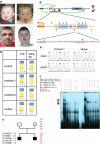Beckwith-Wiedemann syndrome caused by maternally inherited mutation of an OCT-binding motif in the IGF2/H19-imprinting control region, ICR1
- PMID: 21863054
- PMCID: PMC3260935
- DOI: 10.1038/ejhg.2011.166
Beckwith-Wiedemann syndrome caused by maternally inherited mutation of an OCT-binding motif in the IGF2/H19-imprinting control region, ICR1
Abstract
The imprinted expression of the IGF2 and H19 genes is controlled by the imprinting control region 1 (ICR1) located at chromosome 11p15.5. DNA methylation defects involving ICR1 result in two growth disorders with opposite phenotypes: an overgrowth disorder, the Beckwith-Wiedemann syndrome (maternal ICR1 hypermethylation in 10% of BWS cases) and a growth retardation disorder, the Silver-Russell syndrome (paternal ICR1 loss of methylation in 60% of SRS cases). In familial BWS, hypermethylation of ICR1 has been found in association with microdeletion of repetitive DNA motifs within ICR1 that bind the zinc finger protein CTCF; but more recently, ICR1 point mutations were described in BWS pedigrees. We present a case report of two brothers with BWS and prolonged post-pubertal growth resulting in very large stature. A maternally inherited point mutation was identified in ICR1 in both brothers, which altered binding of OCT transcription factors. The same mutation was present on the paternally inherited allele of their unaffected mother. This is a second report of a point mutation causing ICR1 hypermethylation by altering an OCT-binding motif. The atypical growth phenotype of the brothers may be connected to the unusual underlying cause of their BWS.
Figures

References
-
- Sparago A, Cerrato F, Vernucci M, Ferrero GB, Silengo MC, Riccio A. Microdeletions in the human H19 DMR result in loss of IGF2 imprinting and Beckwith-Wiedemann syndrome. Nat Genet. 2004;36:958–960. - PubMed
-
- Cerrato F, Sparago A, Verde G, et al. Different mechanisms cause imprinting defects at the IGF2/H19 locus in Beckwith-Wiedemann syndrome and Wilms' tumour. Hum Mol Genet. 2008;17:1427–1435. - PubMed
Publication types
MeSH terms
Substances
LinkOut - more resources
Full Text Sources
Miscellaneous

